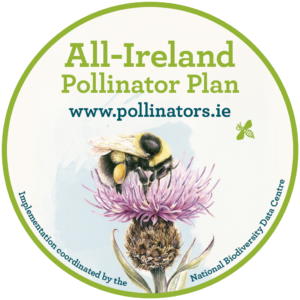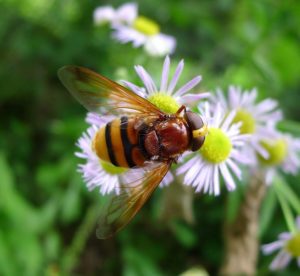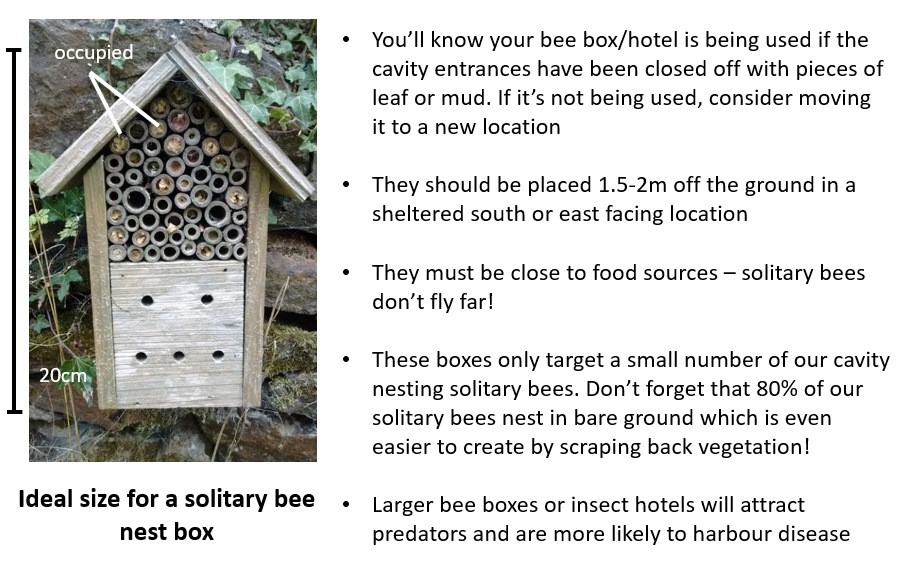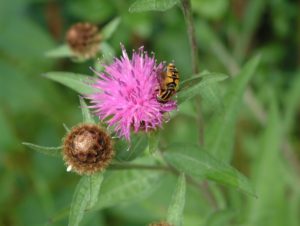All-Ireland Pollinator Plan: August 2023 newsletter

Newsletter: August 2023
The All-Ireland Pollinator Plan is a framework bringing together different sectors across the island of Ireland to create a landscape where pollinators can survive and thrive. Its implementation is coordinated by the National Biodiversity Data Centre.
To spot this month: new hoverfly recorded in Ireland for the first time – can you find any more populations?
The Hornet Plumehorn (Volucella zonaria) established in Britain in the 1940s, and was recorded for the first time in Ireland last month. It was spotted in July by David McAdams & Killian Mullarney at Churchtown in Co Wexford.
It is a very large hoverfly and can be recognised by it’s yellow and black banded abdomen, where the upper band is chestnut in colour. If you think you have spotted it, please take a photograph, and send to us for confirmation.
In Britain, Volucella zonaria occurs in a range of habitats, but can be especially frequent in suburban settings with good populations of Common and German Wasps. The larvae develop as scavengers and larval predators in social wasp nests. In Britain, it occurs from May to November, but peaks in August. Photo: gailhampshire (Wikimedia Commons).

Submit your hoverfly sightings
To do this month: if your bee hotel is not being used, consider moving it to a new location
Now is the perfect time to check if your bee box has been used this year. These boxes are mainly used by two types of solitary bees – leaf cutter bees and mason bees. Leaf cutter bees cut circular pieces of leaves and use them to line the cells in the nest. The Red Mason bee lines the cells of its nest with mud. Check if any of the cavities in your next box are closed off with pieces of leaf or with mud. If there are all still empty, it hasn’t been used this year. In that case, it’s worth moving it to a new location. The more flowers there are around your nest box, the more likely it is to be found and used.

Tralee Wild Bee Festival: 12-13th August
The 2023 Festival is coordinated by the National Biodiversity Data Centre, in collaboration with Kerry County Council, Tralee Bay Wetlands, Transition Kerry, Tralee Tidy Towns and the Irish Wildlife Trust (Kerry branch).
Set in the beautiful surroundings of the Tralee Bay Wetlands, the 2023 festival will feature a series of walks and talks led by biodiversity experts and community groups on these important insects and the simple actions we can take to help them. Admission these events is free. Places are limited on the walks so please contact Tralee Bay Wetlands to register your interest.
There will also be two paid National Biodiversity Data Centre workshops across the weekend, which can be booked here: https://biodiversityireland.ie/workshops/
- Identifying Ireland’s Bumblebees
- Meadow Management & Seed Collecting
These events are primarily aimed at local communities, with most promotion happening locally.
Don’t Mow just yet – August seeds feed next years bees!
‘Don’t Mow, Let it Grow’ meadows are coming towards the end of their cycle for this year. For many of us with longer-flowering meadows, there can be a temptation to mow now as the meadow begins to look dead and less tidy. Hold off if you can! From mid-August many plants will be producing seed, ready to drop into the soil for next year. If you give them a chance to do this, you’ll reap the rewards next year. It’s always good to try to leave the meadows into September before you mow for the year. Note that local authorities, and those with large areas of meadows to manage, may begin cutting earlier for logistic reasons.
Remember, when you do cut – you should remove the cuttings to gradually reduce the soil fertility and give next year’s wildflowers a chance to compete with the more dominant grass species.
Guide on creating meadows in local communities and gardens
Consider collecting some pollinator-friendly wildflower seed locally
Remember, most meadows will develop on their own, if managed properly. However, it is possible to help them along by collecting small amounts of seed from a native meadow near to you. This can be a useful way to boost your own small meadows, patches or strips. Knapweed seed is a good one to begin with. Knapweed typically continues flowering in August-September and provides enormous amounts of nectar for our insects at a time when they really need it.
Based on our blog, Favourite Food for Wild Bees in 2022, Knapweed was the top plant last August. Check out what other plants were important here: https://pollinators.ie/favourite-food-for-wild-bees-in-2022/
Guide: collecting pollinator-friendly wildflower seed

Can you help us promote the Sports Club guidelines?
August is a time when many sports clubs begin their season again. With approximately 15,000 clubs across the island, sports clubs can play a vital role in the conservation of our biodiversity. Our ‘Pollinator-friendly management of Sports Clubs’ guide suggests 10 actions to help pollinators, ranging from reduced mowing on off-pitch grass to planting a native tree walking trail. There are actions for all types of clubs, and both rural and urban, regardless of how much outdoor space a club might have.
If you have links to a local club, we’d hugely appreciate you encouraging them to get involved in helping pollinators-biodiversity.

Can you help by carrying out a Flower-Insect Timed Count (FIT Count)
FIT Counts are an important way that you can help us monitor pollinators. Download the free FIT Count App, watch a 50x50cm patch of flowers for 10 minutes and count how many insects visit. You can carry out a FIT Count anywhere, and on any flower, but where you can, please use one of our 15 target flowers. In August its especially useful to carry out FIT Counts on Knapweed or Ragwort.
In 2022, the average number of insects recorded on a FIT Count was 8. Why not try one where you are to see how your site compares. Please don’t be too discouraged if your 2023 counts are low – the poor weather will have an impact!
For those interested, the National Biodiversity Data Centre also runs a Garden Butterfly Monitoring Scheme. You can help by counting the number of butterflies visiting your garden.
Garden Butterfly Monitoring Scheme

